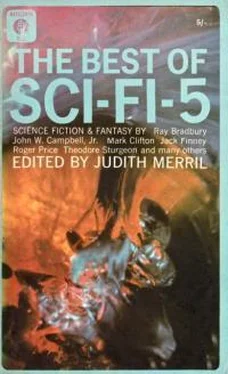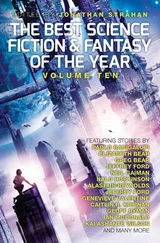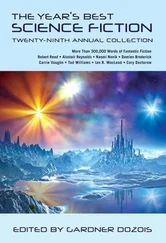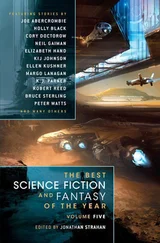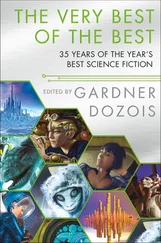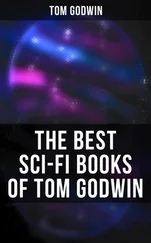The Best of Sci-Fi-5
Здесь есть возможность читать онлайн «The Best of Sci-Fi-5» весь текст электронной книги совершенно бесплатно (целиком полную версию без сокращений). В некоторых случаях можно слушать аудио, скачать через торрент в формате fb2 и присутствует краткое содержание. Год выпуска: 1966, Издательство: Mayflower-Dell, Жанр: Фантастика и фэнтези, на английском языке. Описание произведения, (предисловие) а так же отзывы посетителей доступны на портале библиотеки ЛибКат.
- Название:The Best of Sci-Fi-5
- Автор:
- Издательство:Mayflower-Dell
- Жанр:
- Год:1966
- ISBN:нет данных
- Рейтинг книги:3 / 5. Голосов: 1
-
Избранное:Добавить в избранное
- Отзывы:
-
Ваша оценка:
- 60
- 1
- 2
- 3
- 4
- 5
The Best of Sci-Fi-5: краткое содержание, описание и аннотация
Предлагаем к чтению аннотацию, описание, краткое содержание или предисловие (зависит от того, что написал сам автор книги «The Best of Sci-Fi-5»). Если вы не нашли необходимую информацию о книге — напишите в комментариях, мы постараемся отыскать её.
The Best of Sci-Fi-5 — читать онлайн бесплатно полную книгу (весь текст) целиком
Ниже представлен текст книги, разбитый по страницам. Система сохранения места последней прочитанной страницы, позволяет с удобством читать онлайн бесплатно книгу «The Best of Sci-Fi-5», без необходимости каждый раз заново искать на чём Вы остановились. Поставьте закладку, и сможете в любой момент перейти на страницу, на которой закончили чтение.
Интервал:
Закладка:
That doesn’t mean that ethics is; there are laws of relativity, and it’s not true that any arbitrary system of relationships is just as good as any other.
Can we humans-who-define-humanness-in-emotional-terms—despite what we theoretically say!—meet an equally wise race with different emotions—and know them for fellow humans?
A man who thinks differently we can tolerate and understand, but our history shows we don’t know how to understand a man who feels differently.
The most frightening thing about a man who feels differently is this; his feelings might be contagious. We might learn to feel his way—and then, of course, we wouldn’t be human any more.
The wiser and sounder his different feelings are, the greater the awful danger of learning to feel that way. And that would make us inhuman, of course.
How do you suppose an Athenian Greek of Pericles’s time would have felt if threatened with a change of feelings such that he would not feel disturbed if someone denied the reality of the Gods, or suggested that the Latins had a sounder culture? Why—only a nonhuman barbarian could feel that way!
The interesting thing is that the implication of “inhuman” is invariably sub human.
I suspect one of the most repugnant aspects of Darwin’s concept of evolution was—not that we descended from monkeys—but its implication that something was apt to descend from us! Something that wasn’t human … and wasn’t subhuman.
The only perfect correlation is auto-correlation; “I am exactly what I am.” Any difference whatever makes the correlation less perfect.
Then if what I feel is human—anything different is less perfectly correlated with humanness. Hence any entity not identical is more or less subhuman; there can’t possibly be something more like me than I am.
Anybody want to try for a workable definition of “human”? One warning before you get started too openly; logical discussion doesn’t lead to violence—until it enters the area of emotion.
As of now, we’d have to tell that robot “A human being is an entity having an emotional structure, as well as a physical and mental structure. Never mind what kind of emotional structure—good, indifferent, or insane. It’s the fact of its existence that distinguishes the human.”
Of course, that does lead to the problem of giving the robot emotion-perceptors so he can detect the existence of an emotion-structure.
And that, of course, gets almost as tough as the problem of distinguishing a masquerading demon from a man. You know … maybe they are the same problem?
It’s always puzzled me that in the old days they delected so many demons, and so few angels, too. It always looked as though the Legions of Hell greatly outnumbered the Host of Heaven, or else were far more diligent on Earth.
But then … the subhuman is so much more acceptable than the superhuman.
SIERRA SAM
by Ralph Dighton
from Associated Press
Some years back I got tired of that aching feeling in my head, and resolved never again to pit an opinion of mine against one of John Campbell’s—his are so much stronger.
By now, the habit of responding to Campbellian emphasis only with a) questions, or b) facts, is so ingrained that, lacking a really good question-story …
MAN-LIKE DEVICES USED
IN U. S. TESTS
THEY FEEL HEAT AND COLD, SENSE SHOCK
AND EVEN BREATHE AND BLEED
[Headlines from The New York Times, Jan. 10, 1960.]
LOS ANGELES, Jan. 9 (AP)—The age of the robot is closer than you think.
Synthetic men that can feel heat and cold, sense shock in a way that is equivalent to pain, even bleed and breathe, are in use every day as stand-ins for humans in dangerous experiments.
They are anthropomorphic; that is, they have the shape of men. They are anthropometric, or weighted like men, with a man’s center of gravity.
And they can be made to talk and walk like men whenever the need arises.
They can be bought for $1,500 up, depending on instrumentation.
The $1,500 model can’t do much. He’s the rugged, stupid type that gets thrown out of airplanes to test parachutes.
A $5,000 model rides on rocket sleds and centrifuges, pre-testing the forces of gravity and velocity that man will meet in space travel.
What would a walkie-talkie model cost?
“That’s hard to say. We haven’t made one yet,” says Harry Daulton, President of Sierra Engineering Company in suburban Sierra Madre, the country’s largest manufacturer of the robots.
“But I know we could make one,” he says. “Two producers have asked us about them for science-fiction movies and our engineers said it could be done.”
Daulton’s top seller is Sierra Sam, a six-foot, 200-pounder made of vinyl-dipped foam Latex, with bones and joints of steel and aluminum.
Sam’s midwife and physician is John Meyers, a former truck driver. “He can take 100 G’s,” Mr. Meyers said with pride.
That’s 100 times the force of gravity, or five times as much as a strong-man can take.
Mr. Meyers has made more than 200 Sams, and repaired most of them. Some have come back six or seven times from Air Force tests with their heads torn off, their backs and limbs broken, their bodies slashed, smashed, burnt and bent.
Mr. Meyers simply whips up a batch of foam Latex, pours it from mixer into mold and cures it in an electric oven. After dipping in vinyl, the new torso, head or limb is bolted into place.
The Air Force recently ordered a five-foot-six-inch dummy that may take a ride into space in a Project Mercury capsule one day.
The first Sam was built in 1949. As a maker of prosthetic devices-—artificial arms and legs—Sierra Engineering saw the need for an instrumented human-like shape for rocket-sled speed tests.
The company fabricated a dummy and sold it to the Air Force, where it was promptly dubbed “Sierra Sam,” a name that the company has copyrighted.
Since then Sams have parachuted from planes, tested ejection seats, whirled in centrifuges and crashed in hundreds of cars. They have figuratively saved thousands of lives by improving the safety design of vehicles that man rides in.
Now Sam has been instrumented with electronic devices that sense heat, cold, gravity forces, shock and wind velocity. Other devices closely duplicate human breathing apparatus for determination of what would happen to a man under such stresses.
A DEATH IN THE HOUSE
by Clifford D. Simak
from Galaxy
My first conscious acquaintance with Cliff Simak was in the body of a Jovian “Loper”—a lizard-sort-of-thing through whose keen senses we—Simak and I, along with the hero of the story, and his dog—were able to perceive for the first time the true grandeur of the giant planet’s beauty.
If this sounds like a travelogue, it’s just because it is. I doubt that anyone who read “Desertion” when it was first published in Astounding, or later as part of the prize-winning book. City, has ever quite forgotten the fresh tingling scent of that ammonia storm… .
Well, that was way back; and that was when I started looking for the Simak label on story titles. Exactly what sort of awareness Mr. Simak has that enables him to understand with a unique clarity the nature of strange beasts, I do not know; nor what specialized talent it is that contrives to communicate this empathy so sharply even to such a human-jingoist as me (as cool a clam as ever you’ve come across when it comes to cats and dogs and canaries, yet, let alone alien entities). All I know is that he is a newspaperman in Milwaukee, which is almost far enough away from Milford, Pa., for me to believe—most anything.
Читать дальшеИнтервал:
Закладка:
Похожие книги на «The Best of Sci-Fi-5»
Представляем Вашему вниманию похожие книги на «The Best of Sci-Fi-5» списком для выбора. Мы отобрали схожую по названию и смыслу литературу в надежде предоставить читателям больше вариантов отыскать новые, интересные, ещё непрочитанные произведения.
Обсуждение, отзывы о книге «The Best of Sci-Fi-5» и просто собственные мнения читателей. Оставьте ваши комментарии, напишите, что Вы думаете о произведении, его смысле или главных героях. Укажите что конкретно понравилось, а что нет, и почему Вы так считаете.
